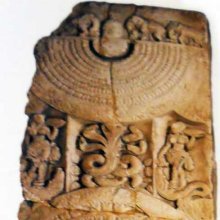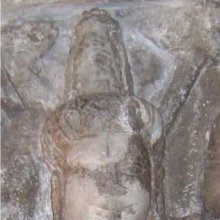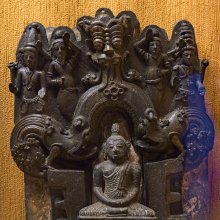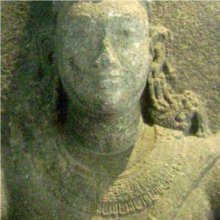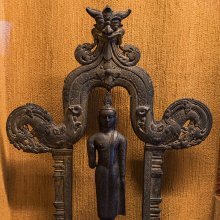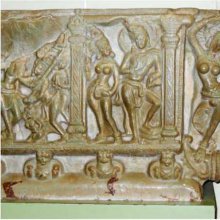Makara, Makāra, Mākara, Mākāra: 46 definitions
Introduction:
Makara means something in Buddhism, Pali, Hinduism, Sanskrit, Jainism, Prakrit, the history of ancient India, Marathi, Hindi, biology. If you want to know the exact meaning, history, etymology or English translation of this term then check out the descriptions on this page. Add your comment or reference to a book if you want to contribute to this summary article.
Alternative spellings of this word include Makar.
Images (photo gallery)
(+41 more images available)
In Hinduism
Natyashastra (theatrics and dramaturgy)
Source: Wisdom Library: Nāṭya-śāstraMakara (मकर) refers to a gesture (āṅgika) made with ‘combined hands’ (saṃyuta), according to the Nāṭyaśāstra chapter 8. The hands (hasta) form a part of the human body which represents one of the six major limbs (aṅga) used in dramatic performance. With these limbs are made the various gestures (āṅgika), which form a part of the histrionic representation (abhinaya).
Source: archive.org: The mirror of gesture (abhinaya-darpana)One of the saṃyutta-hastāni (Twenty-six combined Hands).—Makara: Ardha-candra hands, one enclosing the other, palms downwards, the thumbs moving. Patron deity Mahendra. Usage: the sea, overflowing of a river, deer-face, prosperity, solidity, platform, crocodile.
Source: archive.org: Natya Shastra1) Makara (मकर).—A type of gesture (āṅgika) made with combined hands (saṃyuta-hasta);—(Instructions): When the two Patāka hands with their thumbs raised are turned down and placed on each other the Makara hand is produced. (Uses): It is used to indicate lion, tiger, elephant, crocodile, shark and fish and other carnivorous animals.
2) Makara (मकर).—Description of a women of makara type;—A woman who has a large head, a steady neck, a mouth wide open, very loud voice and is cruel, has habits of a fish, is known to have the nature of a makara.
Source: Shodhganga: Elements of Art and Architecture in the Trtiyakhanda of the Visnudharmottarapurana (natya)Makara (मकर) refers to one of the thirteen Saṃyuktahastas or “combined hand gestures” (in Indian Dramas), according to the Viṣṇudharmottarapurāṇa, an ancient Sanskrit text which (being encyclopedic in nature) deals with a variety of cultural topics such as arts, architecture, music, grammar and astronomy.—The hasta-mudrās (lit. “hand-gestures”) are very essential to denote some particular action or state in dancing and these mudrās are formed with the help of hands and fingers.—According to the Śabdakalpadruma, makara means sea-animals like Kumbhīra, Kūrma, Kāca, Godhā, Śaṅkava, Śvaṇitaka, Śiśumāra etc. According to the Viṣṇudharmottarapurāṇa, in makara posture both of the hands in patāka posture are placed one over the other and both should be facing downward. This posture is used in the acting of lion, tiger and deer.

Natyashastra (नाट्यशास्त्र, nāṭyaśāstra) refers to both the ancient Indian tradition (shastra) of performing arts, (natya—theatrics, drama, dance, music), as well as the name of a Sanskrit work dealing with these subjects. It also teaches the rules for composing Dramatic plays (nataka), construction and performance of Theater, and Poetic works (kavya).
Ayurveda (science of life)
Source: Wisdom Library: Āyurveda and botanyMakara (मकर) is a Sanskrit word referring to the animal “great Indian crocodile”. The meat of this animal is part of the māṃsavarga (‘group of flesh’), which is used throughout Ayurvedic literature. The animal Makara is part of the sub-group named Vāriśaya, refering to animals “living in waters”. It was classified by Caraka in his Carakasaṃhitā sūtrasthāna (chapter 27), a classical Ayurvedic work. Caraka defined such groups (vargas) based on the dietic properties of the substance.
Source: archive.org: Sushruta samhita, Volume IMakara (मकर)—Sanskrit word for a fish (fabulous). This animal is from the group called Sāmudra-matsya (‘marine fish’). Sāmudra-matsya itself is a sub-group of the group of animals known as Ānupa (those that frequent marshy places).
Source: Ancient Science of Life: Snake bite treatment in Prayoga samuccayamMakara (मकर) refers to the month corresponding to January-February, during which time snakes are born being more poisonous than others, according to the 20th century Prayogasamuccaya (one of the most popular and widely practised book in toxicology in Malayalam).—According to the month in which they hatch, their characters differ. In that, the snakes born in caitra month (March- April) will have evil habits, those in dhanu (Dec- Jan) month will be strong and energetic, the ones in makara (Jan- Feb) month will be more poisonous than others. Snakes open their eyes on the 7th day after hatching and take further five days more to gain consciousness and to teeth. In another 30 days, they become poisonous.

Āyurveda (आयुर्वेद, ayurveda) is a branch of Indian science dealing with medicine, herbalism, taxology, anatomy, surgery, alchemy and related topics. Traditional practice of Āyurveda in ancient India dates back to at least the first millenium BC. Literature is commonly written in Sanskrit using various poetic metres.
Purana and Itihasa (epic history)
Source: archive.org: Shiva Purana - English Translation1) Makara (मकर) refers to “sharks”, according to the Śivapurāṇa 2.2.22. Accordingly as Śiva said to Sitā:—“[...] O my beloved, beautiful woman, clouds will not reach the place where I have to make an abode for you. [...] It [viz., the Himālayas] shines with ramparts of crystals, gold and silver. It is lustrous with the lakes—Mānasa and others. It abounds in buds and full-blown lotuses with golden stalks studded with gems. Crocodiles, sharks (makara) and tortoises abound in the lakes”.
2) Makara (मकर) or Makaramatsya refers to a “huge fishes”, acting as Vīrabhadra’s body-guards”, according to the Śivapurāṇa 2.2.33. Accordingly, as Brahmā narrated to Nārada:—“[...] Receiving his command, with his head bowed down in reverence, Vīrabhadra set off immediately to the place of sacrifice. [...] Many strong lions, tigers, crocodiles, huge fishes (makara-matsya) and thousands of elephants constituted his body-guard”.
3) Makara (मकर) refers to a “crocodile” and represents the mount of Varuṇa, according to the Śivapurāṇa 2.2.36. Accordingly, as Brahmā narrated to Nārada:—“Indra mocked at Viṣṇu who was engrossed in his own arguments. He, the bearer of the thunderbolt, was desirous of fighting Vīrabhadra along with the other Devas. [...] Varuṇa rode on a crocodile (makara); the wind-god rode on a deer; Kubera sat in his chariot Puṣpaka and he was ready and alert”.
4) Makāra (मकार) refers to the “letter Ma” (of the alphabet), according to the Śivapurāṇa 2.5.2 (“The Prayer of the gods).—Accordingly, as the Gods eulogized Śiva: “[...] Among the burning ones (pratāpin), you are the fire, among the devotees of Śiva, you are Viṣṇu, among Purāṇas you are Bharata; among the letters of the alphabet you are the letter Ma (makāra). Among the Bījamantras you are the Praṇava; among the terrible ones you are poison; among the pervading ones you are the firmament; among the Ātmans you are the supreme Ātman. [...]”.
Source: archive.org: Puranic EncyclopediaMakara (मकर) or Makaravyūha refers to the “Disposition of an army in the shape of a shark”.—Disposition of an army (vyūha) of four parts, (infantry, cavalry, elephants and chariots) in the battlefield, the arrangement of it, in various forms. It is said that during the period of Mahābhārata, there were various forms of disposition of the army.—Makara-vyūha is mentioned in the Mahābhārata Bhīṣma Parva, Chapter 69.
Source: Cologne Digital Sanskrit Dictionaries: The Purana Index1a) Makara (मकर).—A mountain to the north of Meru.*
- * Bhāgavata-purāṇa V. 16. 27.
1b) A sea monster; gift of a golden one in the ceremony of digging tanks, etc.*
- * Matsya-purāṇa 58. 19.
1c) One of the eight nidhis of Kubera.*
- * Vāyu-purāṇa 41. 10.
1d) The Tamil month, Tai; with Sūrya,1 in the Capricornus; the sun entering which, Uttarāyaṇa commences.2
1e) The sons born to the daughters of Ṛkṣa.*
- * Brahmāṇḍa-purāṇa III. 7. 415.
2) Makāra (मकार).—Is Pluta, consonant and svarloka; the third mātrā is plutavatī, protracted as a vowel.*
- * Vāyu-purāṇa 20. 9, 10, 14.
Makara (मकर) is a name mentioned in the Mahābhārata (cf. I.27) and represents one of the many proper names used for people and places. Note: The Mahābhārata (mentioning Makara) is a Sanskrit epic poem consisting of 100,000 ślokas (metrical verses) and is over 2000 years old.

The Purana (पुराण, purāṇas) refers to Sanskrit literature preserving ancient India’s vast cultural history, including historical legends, religious ceremonies, various arts and sciences. The eighteen mahapuranas total over 400,000 shlokas (metrical couplets) and date to at least several centuries BCE.
Vastushastra (architecture)
Source: Wisdom Library: Vāstu-śāstraMakara (मकर) corresponds with the Capricorn zodiac sign and refers to the tenth of twelve rāśi (zodiacal sign), according to the Mānasāra. Rāśi is one of the three alternative principles, besides the six āyādiṣaḍvarga, used to constitute the “horoscope” of an architectural or iconographic object. Their application is intended to “verify” the measurements of the architectural and iconographic object against the dictates of astrology that lay out the conditions of auspiciousness.
The particular rāśi (e.g., makara) of all architectural and iconographic objects (settlement, building, image) must be calculated and ascertained. This process is based on the principle of the remainder. An arithmetical formula to be used in each case is stipulated, which engages one of the basic dimensions of the object (breadth, length, or perimeter/circumference). All twelve rāśis, except the eighth (vṛścika) are auspicious.
Source: OpenEdition books: Architectural terms contained in Ajitāgama and RauravāgamaMakara (मकर) refers to “upper cross member of an arch § 3.45.”.—(For paragraphs cf. Les enseignements architecturaux de l'Ajitāgama et du Rauravāgama by Bruno Dagens)

Vastushastra (वास्तुशास्त्र, vāstuśāstra) refers to the ancient Indian science (shastra) of architecture (vastu), dealing with topics such architecture, sculpture, town-building, fort building and various other constructions. Vastu also deals with the philosophy of the architectural relation with the cosmic universe.
Vyakarana (Sanskrit grammar)
Source: Wikisource: A dictionary of Sanskrit grammarMakāra (मकार).—The consonant म् (m) with the vowel अ (a) and the affix कार (kāra) added for facility of use and pronunciation; cf. T.Pr.I.17 and 21.

Vyakarana (व्याकरण, vyākaraṇa) refers to Sanskrit grammar and represents one of the six additional sciences (vedanga) to be studied along with the Vedas. Vyakarana concerns itself with the rules of Sanskrit grammar and linguistic analysis in order to establish the correct context of words and sentences.
Jyotisha (astronomy and astrology)
Source: Wisdom Library: Brihat Samhita by Varahamihira1) Makara (मकर) or Mṛga refers to the sign of Capricornus, according to the Bṛhatsaṃhitā (chapter 5), an encyclopedic Sanskrit work written by Varāhamihira mainly focusing on the science of ancient Indian astronomy astronomy (Jyotiṣa).—Accordingly, “If the sun and moon should begin to be eclipsed when only half risen, deceitful men will suffer as well as sacrificial rites. [...] If they should be eclipsed when in the sign of Sagittarius (Dhanuṣa), ministers, fine horses, the Videhas, the Mallānas, the Pāñcālas, physicians, merchants and persons skilled in the use of destructive weapons will perish. If when in the sign of Capricornus (Makara) [i.e., mṛga], fishes, the families of ministers, the Cāṇḍālas, skilled magicians, physicians and old soldiers will perish”.
2) Mākara (माकर) (or Mārgara) refers to a country belonging to “Nairṛtī (south-western division)” classified under the constellations of Svāti, Viśākhā and Anurādhā, according to the system of Kūrmavibhāga, according to the Bṛhatsaṃhitā (chapter 14).—Accordingly, “The countries of the Earth beginning from the centre of Bhāratavarṣa and going round the east, south-east, south, etc., are divided into 9 divisions corresponding to the 27 lunar asterisms at the rate of 3 for each division and beginning from Kṛttikā. The constellations of Svāti, Viśākhā and Anurādhā represent the south-western division consisting of [i.e., Mārgara] [...]”.
Source: Wikibooks (hi): Sanskrit Technical TermsMakara (मकर).—Capricorn. Note: Makara is a Sanskrit technical term used in ancient Indian sciences such as Astronomy, Mathematics and Geometry.

Jyotisha (ज्योतिष, jyotiṣa or jyotish) refers to ‘astronomy’ or “Vedic astrology” and represents the fifth of the six Vedangas (additional sciences to be studied along with the Vedas). Jyotisha concerns itself with the study and prediction of the movements of celestial bodies, in order to calculate the auspicious time for rituals and ceremonies.
Shilpashastra (iconography)
Source: Shodhganga: The significance of the mūla-beras (śilpa)Makara (मकर, “fish”) refers to a type of animal form, representing one of the several “attributes” (āyudha) or “accessories” of a detiy commonly seen depicted in Hindu iconography, defined according to texts dealing with śilpa (arts and crafs), known as śilpaśāstras.—The śilpa texts have classified the various accessories under the broad heading of āyudha or karuvi (implement), including even flowers, animals, and musical instruments. The animals and birds found as vehicles for the deities or held as attributes or weapons in the hands of the deities are, for example, Makara.

Shilpashastra (शिल्पशास्त्र, śilpaśāstra) represents the ancient Indian science (shastra) of creative arts (shilpa) such as sculpture, iconography and painting. Closely related to Vastushastra (architecture), they often share the same literature.
Vaishnavism (Vaishava dharma)
Source: Pure Bhakti: Arcana-dipika - 3rd EditionMakara (मकर) corresponds to “capricorn” (mid January to mid February) and refers to one of the zodiac signs (rāśī) in the Vedic calendar.—Rāśī refers to the different signs of the zodiac through which the sun travels. For precise dates, please refer to a Vedic calendar. In accordance with the zodiac sign the sun is situated in, one would utter [for example, makara-rāśī sthite bhāskare]

Vaishnava (वैष्णव, vaiṣṇava) or vaishnavism (vaiṣṇavism) represents a tradition of Hinduism worshipping Vishnu as the supreme Lord. Similar to the Shaktism and Shaivism traditions, Vaishnavism also developed as an individual movement, famous for its exposition of the dashavatara (‘ten avatars of Vishnu’).
Shaivism (Shaiva philosophy)
Source: SOAS University of London: Protective Rites in the Netra TantraMakara (मकर) refers to one of the animals associated with the Dūtīs associated with Tumburu, according to the Netratantra of Kṣemarāja: a Śaiva text from the 9th century in which Śiva (Bhairava) teaches Pārvatī topics such as metaphysics, cosmology, and soteriology.—Accordingly, [verse 11.1-24ab, while describing the appearance and worship of Tumburu]—“[...] However, those who are Dūtīs bear a form adorned with one face, two arms, and three eyes. Adorning [them is] hair, shorn with scissors. They sit on a fish, a turtle, a makara, and a frog. The servants are two-armed and hold a sword and a hide, [faces bent] in a crooked frown [on their] single faces, [which is adorned with] three eyes. [When] meditated on, [they] burst forth with white, etc., colors, giving the fruits of siddhis. [...]”.

Shaiva (शैव, śaiva) or Shaivism (śaivism) represents a tradition of Hinduism worshiping Shiva as the supreme being. Closely related to Shaktism, Shaiva literature includes a range of scriptures, including Tantras, while the root of this tradition may be traced back to the ancient Vedas.
Shaktism (Shakta philosophy)
Source: Google Books: ManthanabhairavatantramMakāra (मकार) refers to the “letter Ma”, according to the Ambāmatasaṃhitā verse 8.80-85ab.—Accordingly, “And the Transmental at the end of (Mind Beyond Mind) (the energy that begins with) the letter Ma (makāra) is the mother Kubjikā in the triple universe. O Lord of Umā, she is the Command of Vṛkṣanātha who is Ciñca (the Tamarind). Again, he is with you as (Navātman) the great divine Peak syllable. And (so) Śrīnātha, (also called) Ciñcinin, and Tuṣṇin arises at the end of the Transmental. [...]”.

Shakta (शाक्त, śākta) or Shaktism (śāktism) represents a tradition of Hinduism where the Goddess (Devi) is revered and worshipped. Shakta literature includes a range of scriptures, including various Agamas and Tantras, although its roots may be traced back to the Vedas.
General definition (in Hinduism)
Source: Wisdom Library: HinduismMakara (मकर):—Mount of Varuṇa. It is a mythical sea-monster associated with eiter a shark or a crocodile. Varuṇa is the presiding deity of the invisible world and represents the inner reality of things.
Source: WikiPedia: Hinduism1) Makara (Sanskrit: मकर) is a sea-creature in Hindu mythology. It is generally depicted as half terrestrial animal in the frontal part, in animal forms of an elephant, crocodile, stag, or deer, and in the hind part as an aquatic animal, in the form of a fish or seal tail.
2) Makara is the vahana (vehicle) of the Ganga - the goddess of river Ganges (Ganga) and the sea god Varuna. It is also the insignia of the love god Kamadeva.
3) Makara is the astrological sign of Capricorn, one of the twelve symbols of the Zodiac. It is often portrayed protecting entryways to Hindu and Buddhist temples.
4) Makara symbolized in ornaments are also in popular use as wedding gifts for bridal decoration.
In Buddhism
Theravada (major branch of Buddhism)
Source: Pali Kanon: Pali Proper NamesA floodgate in the Parakkamasamudda from which ran the Gambhira Canal. Cv.lxxix.40.
Theravāda is a major branch of Buddhism having the the Pali canon (tipitaka) as their canonical literature, which includes the vinaya-pitaka (monastic rules), the sutta-pitaka (Buddhist sermons) and the abhidhamma-pitaka (philosophy and psychology).
Mahayana (major branch of Buddhism)
Source: Wisdom Library: Maha Prajnaparamita SastraMakara (मकर) refers to the “king of the fish” (matsyarāja) according to a story found in the 2nd century Mahāprajñāpāramitāśāstra chapter 13. Accordingly, “Once there were five hundred merchants who had gone to sea to search for precious stuffs. They encountered Mo k’ie lo (Makara), king of the fish (matsyarāja): the water of the sea rushed into its gaping mouth and the ship was about to be engulfed. The captain (karṇadhāra) asked the man in the look-out: “What do you see?” He answered: “I see three suns (āditya), ranges of white mountains (avadātaparvatarāji) and a waterfall (jalaprapāta) at the entrance to a cave.” The captain shouted: “It is the Makara, the king of the fish; he is holding his mouth agape; the first sun is the real sun, the other two suns are his eyes (akṣi); the white mountains are his teeth (danta): the waterfall is the sea water that is rushing into his mouth.”
Makara (मकर) refers to the “Makaras” (situated in the lotus-lake near Aḍakavatī), according to the Vajratuṇḍasamayakalparāja, an ancient Buddhist ritual manual on agriculture from the 5th-century (or earlier), containing various instructions for the Sangha to provide agriculture-related services to laypeople including rain-making, weather control and crop protection.—Accordingly, [when the Bhagavān reached the vicinity of the residence of Vaiśravaṇa], “[...] That lotus lake was covered by various blue lotuses, lotuses, white water-lilies and white lotuses. It contained various fish, Makaras (makara), Timiṅgilas, alligators, bees and various other water-born beings. [...]”

Mahayana (महायान, mahāyāna) is a major branch of Buddhism focusing on the path of a Bodhisattva (spiritual aspirants/ enlightened beings). Extant literature is vast and primarely composed in the Sanskrit language. There are many sūtras of which some of the earliest are the various Prajñāpāramitā sūtras.
Tibetan Buddhism (Vajrayana or tantric Buddhism)
Source: Wisdom Library: Tibetan BuddhismMakara (मकर) is the name of a Rāśi (zodiac sign) mentioned as attending the teachings in the 6th century Mañjuśrīmūlakalpa: one of the largest Kriyā Tantras devoted to Mañjuśrī (the Bodhisattva of wisdom) representing an encyclopedia of knowledge primarily concerned with ritualistic elements in Buddhism. The teachings in this text originate from Mañjuśrī and were taught to and by Buddha Śākyamuni in the presence of a large audience (including Makara).
Source: academia.edu: The Structure and Meanings of the Heruka MaṇḍalaMakara (मकर) is the name of a Vīra (hero) who, together with the Ḍākinī named Makarī forms one of the 36 pairs situated in the Jalacakra, according to the 10th century Ḍākārṇava chapter 15. Accordingly, the jalacakra refers to one of the three divisions of the saṃbhoga-puṭa (‘enjoyment layer’), situated in the Herukamaṇḍala. The 36 pairs of Ḍākinīs and Vīras [viz., Makara] are white in color; the shapes of their faces are in accordance with their names; they have four arms; they hold a skull bowl, a skull staff, a small drum, and a knife..

Tibetan Buddhism includes schools such as Nyingma, Kadampa, Kagyu and Gelug. Their primary canon of literature is divided in two broad categories: The Kangyur, which consists of Buddha’s words, and the Tengyur, which includes commentaries from various sources. Esotericism and tantra techniques (vajrayāna) are collected indepently.
In Jainism
General definition (in Jainism)
Source: archive.org: Trisastisalakapurusacaritra1) Mākāra (माकार) is the name of a law promulgated by Yaśasvin, according to chapter 1.2 [ādīśvara-caritra] of Hemacandra’s 11th century Triṣaṣṭiśalākāpuruṣacaritra: an ancient Sanskrit epic poem narrating the history and legends of sixty-three illustrious persons in Jainism.—Accordingly, “[...] then Yaśasvin, like his father, controlled all the twins easily for a long time, as a cow-herd controls cows. Then gradually the Hākāra was disregarded by the twins, like the elephant-goad by elephants whose internal-ichor is appearing. Yaśasvin made the Mākāra punishment to curb them. In a disease that can not be subdued by one remedy, another remedy must certainly be applied. He, having great judgment, used the first law for a small offense, the second one for a moderate offense; and both in a serious offense”.
2) Makara (मकर) refers to one of the warriors in Rāvaṇa’s army, according to the Jain Ramayana and chapter 7.7 [The killing of Rāvaṇa].—Accordingly, “[...] When the battle had been going on for a long time, the army of the Rākṣasas was broken by the Vānaras like a forest by winds. [...] From anger at the killing of Hasta and Prahasta, [Makara, ...] and others in Daśānana’s army advanced. [...] Then the soldiers of Rāma and Rāvaṇa returned, purifying their own men, killed and unkilled”.

Jainism is an Indian religion of Dharma whose doctrine revolves around harmlessness (ahimsa) towards every living being. The two major branches (Digambara and Svetambara) of Jainism stimulate self-control (or, shramana, ‘self-reliance’) and spiritual development through a path of peace for the soul to progess to the ultimate goal.
India history and geography
Source: archive.org: Ceylon Branch of the Royal Asiatic Society 1963Makara is the name of a sluice associated with Gambhīrā: one of the twenty canal-systems associated with Parakkamasamudda waters that existed in the Polonnaruva (Polonnaruwa) district of Ceylon (Sri Lanka).—The Pūjāvaliya gives the name Mahāsamudra to the Parakkamasamudda at Polonnaruva. The canal system associated with Parakkamasamudda is described and named in the Cūlavamsa as follows:—[...] Gambhīrā canal, from the Makara sluice; [...].

The history of India traces the identification of countries, villages, towns and other regions of India, as well as mythology, zoology, royal dynasties, rulers, tribes, local festivities and traditions and regional languages. Ancient India enjoyed religious freedom and encourages the path of Dharma, a concept common to Buddhism, Hinduism, and Jainism.
Biology (plants and animals)
Source: Google Books: CRC World Dictionary (Regional names)Makara in India is the name of a plant defined with Dactyloctenium aegyptium in various botanical sources. This page contains potential references in Ayurveda, modern medicine, and other folk traditions or local practices It has the synonym Cynosurus aegyptius L. (among others).
Example references for further research on medicinal uses or toxicity (see latin names for full list):
· Tableau Encyclopédique et Méthodique … Botanique (1791)
· Nomenclator Botanicus. Editio secunda (1840)
· Plantae Europeae (1870)
· Précis des Découvertes et Travaux Somiologiques (1814)
· Revised Handbook to the Flora of Ceylon (1931)
· Grasses of Ceylon (1956)
If you are looking for specific details regarding Makara, for example health benefits, side effects, chemical composition, pregnancy safety, diet and recipes, extract dosage, have a look at these references.

This sections includes definitions from the five kingdoms of living things: Animals, Plants, Fungi, Protists and Monera. It will include both the official binomial nomenclature (scientific names usually in Latin) as well as regional spellings and variants.
Languages of India and abroad
Pali-English dictionary
Source: BuddhaSasana: Concise Pali-English Dictionarymakara : (m.) a sea-monster; a sword-fish.
Source: Sutta: The Pali Text Society's Pali-English DictionaryMakara, (cp. Epic Sk. makara) a mythical fish or sea monster, Leviathan (cp. Zimmer, Altind. Leben 97) J. II, 442; III, 188; Miln. 131, 377; ThA. 204.—f. makarinī Miln. 67.

Pali is the language of the Tipiṭaka, which is the sacred canon of Theravāda Buddhism and contains much of the Buddha’s speech. Closeley related to Sanskrit, both languages are used interchangeably between religions.
Marathi-English dictionary
Source: DDSA: The Molesworth Marathi and English Dictionarymakara (मकर).—m (S) An aquatic monster understood usually of the alligator, crocodile, and shark, but, properly, a fabulous animal. It is the emblem of the god of love. 2 One of the signs of the zodiac. It corresponds with Capricorn.
--- OR ---
makara (मकर).—n ( A) Fraud, feint, pretence, sham: also craft or cunning.
Source: DDSA: The Aryabhusan school dictionary, Marathi-Englishmakara (मकर).—m A crocodile. The sign Capri- corn. n Fraud.
Marathi is an Indo-European language having over 70 million native speakers people in (predominantly) Maharashtra India. Marathi, like many other Indo-Aryan languages, evolved from early forms of Prakrit, which itself is a subset of Sanskrit, one of the most ancient languages of the world.
Sanskrit dictionary
Source: DDSA: The practical Sanskrit-English dictionaryMakara (मकर).—[maṃ viṣaṃ kirati kṝ-ac Tv.]
1) A kind of seaanimal, a crocodile, shark; झषाणां मकरश्चास्मि (jhaṣāṇāṃ makaraścāsmi) Bhagavadgītā (Bombay) 1.31; मकरवक्त्र (makaravaktra) Bhartṛhari 2.4. (Makara is regarded as an emblem of Cupid; cf. comps. below).
2) The sign Capricornus of the zodiac.
3) An array of troops in the form of a Makara; दण्डव्यूहेन तन्मार्गं यायात्तु शकटेन वा । वराहमकराभ्यां वा (daṇḍavyūhena tanmārgaṃ yāyāttu śakaṭena vā | varāhamakarābhyāṃ vā) ... Manusmṛti 7.187; Śukra.4.11.
4) An ear-ring in the shape of a Makara.
5) The hands folded in the form of a Makara.
6) Name of one of the nine treasures of Kubera.
7) The tenth arc of thirty degrees in any circle.
Derivable forms: makaraḥ (मकरः).
--- OR ---
Makāra (मकार).—
1) The syllable म (ma).
2) Each of the following five मद्य, मत्स्य, मांस, मैथुन (madya, matsya, māṃsa, maithuna) and मुद्रा (mudrā); see पञ्चमकार (pañcamakāra).
Derivable forms: makāraḥ (मकारः).
--- OR ---
Mākara (माकर).—a. (-rī f.) Belonging to the sea-monster, Makara q. v.
-rī Name of the seventh day in the bright half of Māgha; तन्मे रोगं च शोकं च माकरी हन्तु सप्तमी (tanme rogaṃ ca śokaṃ ca mākarī hantu saptamī) Tithyādi.
Source: Cologne Digital Sanskrit Dictionaries: Edgerton Buddhist Hybrid Sanskrit DictionaryMakara (मकर).—name of a nāga king: Mahāvyutpatti 3236; Mahā-Māyūrī 247.5.
Source: Cologne Digital Sanskrit Dictionaries: Shabda-Sagara Sanskrit-English DictionaryMakara (मकर).—m.
(-raḥ) 1. A marine monster, confounded usually with the crocodile and shark, but properly a fabulous animal: as a fish it might be conjectured to be the horned-shark, or the unicorn fish; but it is often drawn, as it in the pictured sign Capricornus of the zodiac, with the head and forelegs of an antelope, and the body and tail of a fish: it is the emblem of the god of love. 2. One of the signs of zodiac, corresponding with the above, and like the Greek representation of that sign, being an animal in the foreparts, and ending in the tail of a fish. One of the nine treasures of Kuvera. 3. A particular array of troops, in the form of a Makara. 4. An ear-ring in that shape. E. ma for mukha the mouth, kṛ to scatter, aff. ac; or māṅ prohibitive aff., kṛ to do, ac aff., form irr.; grammarians however, sometimes consider this word as a primitive.
--- OR ---
Mākara (माकर).—f. (-rī) Belonging to the sea-monster Makara.
Source: Cologne Digital Sanskrit Dictionaries: Benfey Sanskrit-English DictionaryMakara (मकर).—I. m. 1. A marine monster confounded usually with the crocodile and shark, but properly a fabulous animal, [Johnson's Selections from the Mahābhārata.] 28, 27; [Pañcatantra] 51, 9; iv. [distich] 1. 2. One of the signs of the zodiac. 3. A form of marching an army, [Mānavadharmaśāstra] 7, 187. 4. One of Kuvera's treasures. Ii. f. rī, The wife of the marine monster called makara, [Pañcatantra] 206, 14.
Source: Cologne Digital Sanskrit Dictionaries: Cappeller Sanskrit-English DictionaryMakara (मकर).—[masculine] ī [feminine] a kind of sea monster (the emblem of the god of love); array of troops in the form of a [Middle]
--- OR ---
Makāra (मकार).—[masculine] the sound ma.
--- OR ---
Mākara (माकर).—[feminine] ī relating to the sea monster Makara.
Source: Cologne Digital Sanskrit Dictionaries: Monier-Williams Sanskrit-English Dictionary1) Makāra (मकार):—[=ma-kāra] [from ma] 1. ma-kāra m. the letter or sound ma, [Śāṅkhāyana-brāhmaṇa; Atharva-veda.Pariś] etc.
2) [=ma-kāra] [from ma] 2. ma-kāra m. the foot called molossus
3) Makara (मकर):—m. a kind of sea-monster (sometimes confounded with the crocodile, shark, dolphin etc.; regarded as the emblem of Kāma-deva cf. makara-ketana etc. below or as a symbol of the 9th Arhat of the present Avasarpiṇī; represented as an ornament on gates or on head-dresses), [Vājasaneyi-saṃhitā] etc. etc.
4) a [particular] species of insect or other small animal, [Suśruta]
5) Name of the 10th sign of the zodiac (Capricornus), [Sūryasiddhānta; Varāha-mihira] etc.
6) the 10th arc of 30 degrees in any circle, [cf. Lexicographers, esp. such as amarasiṃha, halāyudha, hemacandra, etc.]
7) an army of troops in the form of a M°, [Manu-smṛti vii, 187]
8) an ear-ring shaped like a M°, [Bhāgavata-purāṇa] (cf. makara-kuṇḍala)
9) the hands folded in the form of a M°, [Catalogue(s)]
10) one of the 9 treasures of Kubera, [cf. Lexicographers, esp. such as amarasiṃha, halāyudha, hemacandra, etc.]
11) one of the 8 magical treasures called Padminī, [Mārkaṇḍeya-purāṇa]
12) a [particular] magical spell recited over weapons, [Rāmāyaṇa]
13) Name of a mountain, [Bhāgavata-purāṇa]
14) Mākara (माकर):—mf(ī)n. relating or belonging to a Makara or sea-monster (with ākara m. mine of M°, the sea, [Nalôd.]; with ācana n. a [particular] posture in sitting, [Catalogue(s)]; with vyūha m. a [particular] form of military array, [Harivaṃśa]; with saptamī f. = makara-saptamī, [Horace H. Wilson])
15) m. [plural] Name of a people, [Varāha-mihira’s Bṛhat-saṃhitā]
Source: Cologne Digital Sanskrit Dictionaries: Yates Sanskrit-English DictionaryMakara (मकर):—(raḥ) 1. m. A marine monster; sign of the zodiac, Capricorn; one of Kuvera's treasures.
Source: DDSA: Paia-sadda-mahannavo; a comprehensive Prakrit Hindi dictionary (S)Makāra (मकार) in the Sanskrit language is related to the Prakrit words: Maṃkāra, Makkāra, Magara, Mayara, Mayāra.
[Sanskrit to German]
Sanskrit, also spelled संस्कृतम् (saṃskṛtam), is an ancient language of India commonly seen as the grandmother of the Indo-European language family (even English!). Closely allied with Prakrit and Pali, Sanskrit is more exhaustive in both grammar and terms and has the most extensive collection of literature in the world, greatly surpassing its sister-languages Greek and Latin.
Hindi dictionary
Source: DDSA: A practical Hindi-English dictionaryMakara (मकर) [Also spelled makar]:—(nm) the Capricornus-tenth sign of the zodiac; a crocodile; one of the nine nidhis of Kuber-the god of wealth; hence [makarī] (nf); ~[ketana/ketu/dhvaja] Cupid-the god of love; ~[rekhā] tropic of the Capricorn; -[saṃkrāṃti] the day of transition in the month of [māgha] when the sun enters the mansion Capricornus.
...
Kannada-English dictionary
Source: Alar: Kannada-English corpusMakara (ಮಕರ):—
1) [noun] any of several flesh-eating crocodilians of the genus Crocodylus, having thick, horny skin, long tail, a long, narrow triangular head, large jaws, found in sluggish waters and swamps of the tropics; a crocodile.
2) [noun] any of a group of large cartilaginous marine fishes, having rounded body & underside mouth, tough, spiny skin, voracious, and, which sometime attack to humans; shark.
3) [noun] (myth.) one of the nine treasures of Kubera, the regent of wealth.
4) [noun] a military array in which troops are arranged in the form of a corodile.
5) [noun] (astrol.) the tenth sign of the zodiac; the Capricorn.
6) [noun] (dance) a hand gesture, in which one palm is place on the back of another hand, with thumbs of both the hands stretched apart and other fingers stretched forward.
--- OR ---
Makara (ಮಕರ):—[noun] a small flat-roofed, temporary structure, raised on four pillars having no walls on any side, which is gaily decorated, for keeping an idol.
--- OR ---
Makāra (ಮಕಾರ):—[noun] the letter 'ಮ' (pronounced with the vowel ಅ).
Kannada is a Dravidian language (as opposed to the Indo-European language family) mainly spoken in the southwestern region of India.
See also (Relevant definitions)
Starts with (+146): Makara Sankaranti, Makara-nuhaunu, Makara-vaymotiram, Makarabhojana, Makarabibbi, Makarabubel, Makaracaka, Makaracam, Makaracamuli, Makaracankiramanam, Makaracatam, Makaracca, Makaraccayam, Makaraci, Makaracuvan, Makaradamshtra, Makaradantaka, Makaradhaja, Makaradhvaja, Makaradhvajaprasara.
Ends with (+59): Adhikarmakara, Agnimakara, Ahimakara, Akaramakara, Angarakammakara, Ashmakara, Atmakara, Bhagavatpada-karmakara, Bhamakara, Bhasmakara, Bhimakara, Bhritikarmakara, Brahmakara, Cakaramakara, Cammakara, Carmakara, Carmmakara, Charmakara, Charmmakara, Dasakammakara.
Full-text (+360): Makarakundala, Makaraketu, Minara, Pancamakara, Pangugraha, Makarapancaka, Asidamshtra, Makarakara, Makarin, Makarashva, Makaratorana, Makaradhvaja, Pankagraha, Umakara, Mayara, Makaravasa, Makari, Makaradhyana, Makarayana, Makarasaptami.
Relevant text
Search found 103 books and stories containing Makara, Ma-kara, Ma-kāra, Makāra, Mākara, Mākāra; (plurals include: Makaras, karas, kāras, Makāras, Mākaras, Mākāras). You can also click to the full overview containing English textual excerpts. Below are direct links for the most relevant articles:
Shrimad Bhagavad-gita (by Narayana Gosvami)
Verse 10.31 < [Chapter 10 - Vibhūti-yoga (appreciating the opulences of the Supreme Lord)]
Early Chola Temples (by S. R. Balasubrahmanyam)
Torana < [Chapter XIII - Prasada: Component Parts]
Temples in Pullamangai (Pasupati Koyil) < [Chapter II - Temples of Parantaka I’s Time]
Iravasthana Isvaram < [Chapter XIV - Conclusion]
Puranic encyclopaedia (by Vettam Mani)
Amaravati Art in the Context of Andhra Archaeology (by Sreyashi Ray chowdhuri)
Animal figures < [Chapter 5 - Impact of Amarāvatī Art]
Amarāvatī impact on later schools of Indian art < [Chapter 5 - Impact of Amarāvatī Art]
Resemblance to Mathurā art < [Chapter 5 - Impact of Amarāvatī Art]
Shishupala-vadha (Study) (by Shila Chakraborty)
Bhoga-vyūha (Snake array): < [Chapter 6 - Principles of Warfare]
Arrangement of Array (vyūha) (Introduction) < [Chapter 6 - Principles of Warfare]
Various other Arrays < [Chapter 6 - Principles of Warfare]
Bhajana-Rahasya (by Srila Bhaktivinoda Thakura Mahasaya)
Related products
